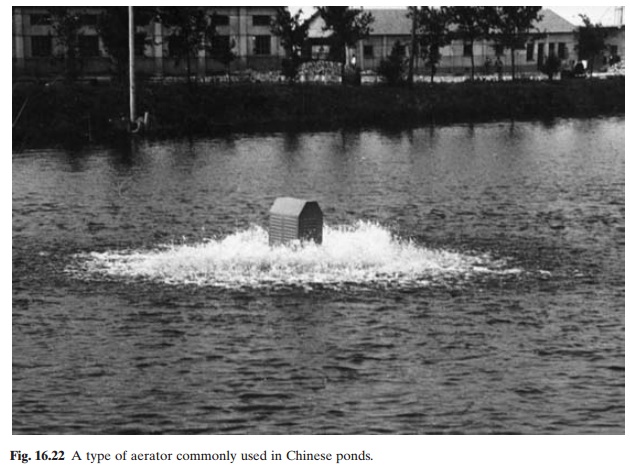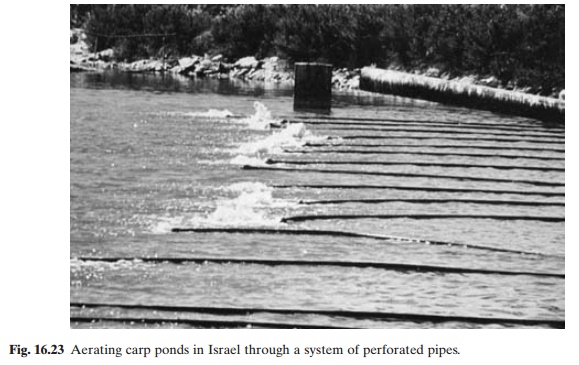Chapter: Aquaculture Principles and Practices: Carps
Diseases and mortality of Carps
Diseases and mortality
A number of diseases that affect carps have been described and
consideration was given to the role of the environment in the prevalence of
diseases and mortality of stocks. The culture system and culture technologies
also play an important role in the occurrence of diseases. Diseases are
generally less rampant in extensive types of carp culture in comparison to
intensive systems like cage rearing. Intensively stocked polyculture carp ponds
in China are heavily loaded with organic manure and bacterial, fungal and viral
diseases are comparatively common in these. Haemorrhagic septi-caemia,
gill-rot, enteritis, Myxosporidiasis, Ichthyophthiriasis, Dactylogyrosis,
Trichodinia-sis, Saprolegniasis, Synergasilosis and Lernaeo-sis are common in
the carp ponds.
Enteritis in Chinese carp ponds is caused by Aeromonas punctata and can be recognized byerythema on the abdomen,
decayed fin rays and swollen and reddish anal openings. The intestine becomes
purplish in colour and the blood capillaries are inflamed. The intestine is
filled with pus-like slime and ulcerated mucus membrane. Grass carp is the main
species affected and mortalities of up to 70–90 per cent can occur,
particularly during the period May/June. Poor feeds are believed to be responsible
for weakening resistance to the pathogen. Disinfection with bleaching powder
and provision of better feeds and feeding methods are rec-ommended as
preventive measures. As a cure, treatment with medicated feeds containing
sulphaguanidine, at a dose of 10g per 100kg body weight of fish on the first
day, and half that from the second to the sixth day, is reported to be
effective.
Myxobolusis is one of the common Myx-osporidian diseases of grass carp,
particularly dangerous to fry when the ponds are heavily stocked and food
availability is low. The spore of the parasite attaches to the intestine of the
fish. The plasmodium that emerges from the spore sucks nutrition from the host
and develops into spores on the intestinal wall. As a result, heavy mortality
of fry can occur. The control measure is thinning the stock to enable better
growth and resistance to infection.
Infestation by the tape worm Bothriocephalus
gowkongensis is also reported to occurin young grass carp below 10cm in
length, but not in the adult. The diseased fry is milk-white in colour, thin
and feeble, and suffers from per-nicious anaemia. The intermediate host is a
cyclops, in which the coracidium of the worm undergoes its development into
procercoid. When the grass carp fry eats the infected cyclops, the procercoid
develops into plerocercoid and adult stages. Mortality caused by the infection
can be as high as 90 per cent during winter seasons. The only means of
eradicating the parasite is by disinfecting the pond with quicklime at a concentration
of 0.5ppt.
In polyculture ponds in India, Ichthyoph-thiriasis, fin and tail rot, Saprolegniasis and infestation by Argulus, Lernaea and Ergasilus are common. The major diseases in carp ponds in Israel
are also similar. Carp ponds in Eastern and Western Europe appear to be more
prone to disease problems. It is believed that this is related to the greater
stress that the fish are exposed to during severe winters. The problem of
infectious dropsy of carp has already been discussed. Gill-rot or branchiomy-cosis,
costiasis, icthyophthiriasis and dactylogy-rosis are the other more common
diseases affecting carp in Europe.
One of the major causes of large-scale mortality in carp ponds,
particularly in tropical and sub-tropical regions, is oxygen deficiency and
resultant anoxia of fish. As carp culture is mainly done in highly manured
ponds with dense stocking of fish, there is a greater chance of oxygen
deficiency occurring. The rate of oxygen production through photosynthesis is
very high during day time in highly fertilized ponds with a rich growth of
phytoplankton. During the night, photosynthesis and oxygen production cease and
the only source of dissolved oxygen is the atmospheric oxygen dissolved in the
water due to wind and water movements. The consumption of oxygen by the
organisms in the pond continues throughout day and night and in highly
productive fish ponds the balance may be greatly affected. Oxygen deficiency
and anoxia can occur if the conditions are not properly monitored and the necessary
action taken to rectify it. Though dense growths of algae produce oxygen, they
also reduce light penetration in ponds and reduce oxygen production through
photosyn-thesis in the lower layers. Intensive manuring, which increases the
organic loading of pond waters, results in high rates of production of
bacteria, protozoa, zooplankton, etc., thus adding to oxygen expenditure. High
temperatures lead to a lower dissolved oxygen concentration in water and
stimulate higher consumption of oxygen through increased respiration. Under
cloudy atmospheric conditions, photosynthesis and dissolved oxygen production
are reduced as a result of lower light irradiation and this often causes
large-scale mortality due to anoxia under monsoon weather conditions in Asian countries.
Fish that feed on microscopic algae, like the silver carp, and those
that feed on zooplankton,
like the bighead, can help in controlling the occurrence of anoxia. The
presence of detritus-feeding fish helps to reduce the accumulation of organic matter.
Even when special care is taken to stock ponds with proper ratios of these
species, unfavourable conditions can arise. In such circumstances, the two most
common measures adopted are addition or exchange of water and aeration. The
addition of fresh water, if possible by cascading or spraying, increases the
dissolved oxygen content of the ponds. Where possible, it is better to drain
some of the pond water and replace it with fresh, well-oxygenated water from an
outside source, or even pump back the same water in a spray so as to increase
the dissolved oxygen content to about 3ml/l. Aeration is a more efficient means
of controlling the depletion of oxygen.
Different types of aerators are now in use in fish ponds (figs 16.22 and
16.23). Kepenyes and Varadi (1984) divided pond aeration into two
types: hydraulic and air diffusion. A water pump is the basic device for
hydraulic aeration, whereby the energy content of the water is increased. The
air intake device can be a cascade, a sprinkler, an ejector or an air-intake
head. Surface aeration can be provided by a simple open impeller or a
centrifugal pump. The basic unit of an air diffusion aeration device is the air
compressor, which can be a root-type blower, a ventilator, a compressor or a
membrane pump. The air penetrates the water through a porous material or
perforated tubes installed in the pond. When the air is diffused through a
perforated pipe, large bubble of up to 10mm in diameter are formed. If the
diffusor is a porous material, fine bubbles of 2– 5mm diameter can be produced.
The smaller the bubbles, the larger is the total surface for a given volume of
air and the lower their buoy-ancy, which improves oxygen transfer. As the
bubbles pass through water, part of their

When a sprinkler is used, the water jet comes from the nozzle with high
velocity and falls into the water in drops. The turbulence caused when the water
drops hit the water surface increases the diffusion of air into the water. The
water jet can be directed down into the water surface, forcing air bubbles into
the water. When aeration is performed with an ejector, the water is passed
through a venturi-type diffusor where its pressure is reduced below the
atmospheric pressure, thus allowing air to penetrate into the water. Special
air-intake heads consist of a propeller inside a pipe through which water
passes. As the propeller is driven by the water current, the pressure decreases
on the surface of the blades and the air is sucked in. Cascades can be used for
aeration and break the water into small drops, increasing the interfacial area.

Surface aerators are placed directly in the fish pond and, by rotation
of a paddle-wheel device with a vertical or horizontal axis, water is
discharged into the air. These aerators generate a vertical or horizontal water
current in the fish pond.
In carp ponds in China, aerators have become standard equipment.
Frequent operation, often once a day for an hour or two, has been found to
increase yields by as much as 14–28 per cent, as a result of better circulation
of nutrients and consequent plankton growth. At times of oxygen deficiency,
aerators are operated for two or three hours in the morning or around noon,
particularly on overcast days.
Related Topics